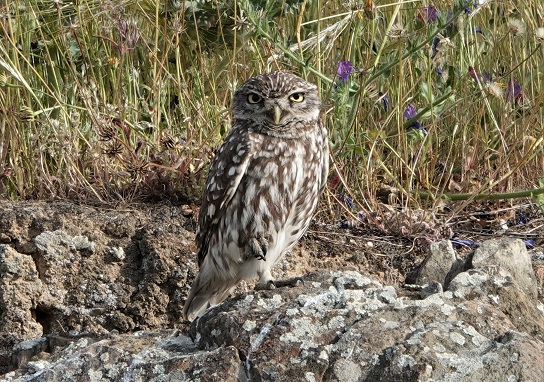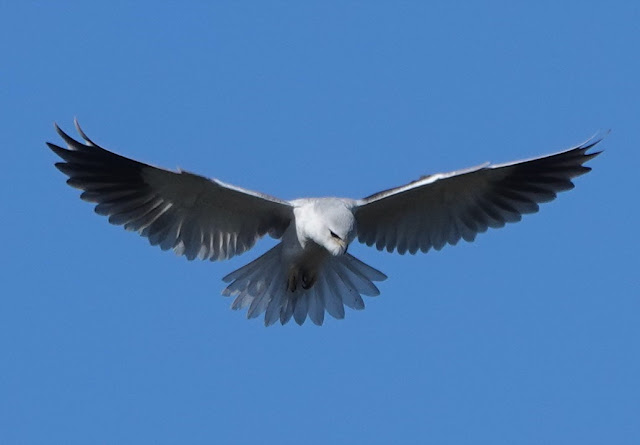Dance Imperial
Sometimes the best comes last. It was a mid-November day with frontal systems bringing bands of overcast weather and gusts of wind, with brief breaks in the cloud with sunshine. It was just the day to be out in wide-open spaces, on the plains, under the vast dome of sky with its ever-changing tones, vast brushstrokes of whites, greys and blues. This was the sort of day when the big birds of prey, like the vultures, could drift across a whole field of view, with barely a flap, cruising rather than soaring. A few skeins of cranes and geese were moving southwest. On the plains themselves we found parties of Great and Little Bustard and a flock of over a hundred Pin-tailed Sandgrouse busy feeding on a short sward of fresh autmun grass.
We left the vehicle and walked east along an ancient drovers' trail, a Cañada Real, established by Royal (= "Real") decree early in Medieval times. For centuries these were the routes taken by the drovers and their herds of cattle or flocks of sheep, like nomadic pastorists bringing their animals off the northern mountains in the autumn, following the landscape as it became green after the October rains to grazing pastures to the south. They retraced their steps in the spring: thousands of animals moving along these strips of common land. This transhumance has almost died out and most of the movement is today by truck, but the trails remain as ribbons of public land, now marked with little granite posts bearing the initials VP ("Via Pecuaria" or Livestock trail). They give wonderful access across plains and into dehesa woodland and it was along one of these we spent the afternoon.
We headed initially across mixed farming land, rough pastures and cereals, but quickly the landscape because dominated by lavander with scattered bushy holm oaks. It was superb open terrain and looked excellent for eagles, indeed as we walked we flushed a couple of Iberian Hares, a much-favoured prey species of Golden Eagle here. However, by now we were being grazed by a belt of heavy rain, which although staying mercifully just to our west, made the sky damp and gloomy - certainly not good eagle weather. The breeze eventually carried the heavy shower onwards and away and gradually a few Griffon Vultures started to rise in the sky. I caught a glimpse of an eagle flying low, perhaps a couple of kilometres away, but soon it was gone. Shafts of late afternoon sunlight penetrated the thick cloud and a rainbow appeared over the path ahead. At that moment I heard a barking call, somewhat higher in tone than a Raven - unmistakeably the sound of a Spanish Imperial Eagle announcing its arrival. It quickly moved on stage, wings held close to its body, and then swooped upwards getting higher and higher, before turning to stoop downwards. This it repeated as its mate arrived from the same direction and we witnessed the sheer joy of the pair sky-dancing, rising and falling in magnificent loops, with sunlight catching their brilliant white leading edges to their wings, with sometimes a backdrop of moody storm clouds, and sometimes against patches of clear blue sky.
It was one of those moments when we, as observers, could feel both immensely privileged and at the same time extraordinarily humble, for to the eagles we must have been just mere earth-tied specks as they proclaimed their dominance of the skies in their courtship dance.
We left the vehicle and walked east along an ancient drovers' trail, a Cañada Real, established by Royal (= "Real") decree early in Medieval times. For centuries these were the routes taken by the drovers and their herds of cattle or flocks of sheep, like nomadic pastorists bringing their animals off the northern mountains in the autumn, following the landscape as it became green after the October rains to grazing pastures to the south. They retraced their steps in the spring: thousands of animals moving along these strips of common land. This transhumance has almost died out and most of the movement is today by truck, but the trails remain as ribbons of public land, now marked with little granite posts bearing the initials VP ("Via Pecuaria" or Livestock trail). They give wonderful access across plains and into dehesa woodland and it was along one of these we spent the afternoon.
We headed initially across mixed farming land, rough pastures and cereals, but quickly the landscape because dominated by lavander with scattered bushy holm oaks. It was superb open terrain and looked excellent for eagles, indeed as we walked we flushed a couple of Iberian Hares, a much-favoured prey species of Golden Eagle here. However, by now we were being grazed by a belt of heavy rain, which although staying mercifully just to our west, made the sky damp and gloomy - certainly not good eagle weather. The breeze eventually carried the heavy shower onwards and away and gradually a few Griffon Vultures started to rise in the sky. I caught a glimpse of an eagle flying low, perhaps a couple of kilometres away, but soon it was gone. Shafts of late afternoon sunlight penetrated the thick cloud and a rainbow appeared over the path ahead. At that moment I heard a barking call, somewhat higher in tone than a Raven - unmistakeably the sound of a Spanish Imperial Eagle announcing its arrival. It quickly moved on stage, wings held close to its body, and then swooped upwards getting higher and higher, before turning to stoop downwards. This it repeated as its mate arrived from the same direction and we witnessed the sheer joy of the pair sky-dancing, rising and falling in magnificent loops, with sunlight catching their brilliant white leading edges to their wings, with sometimes a backdrop of moody storm clouds, and sometimes against patches of clear blue sky.
It was one of those moments when we, as observers, could feel both immensely privileged and at the same time extraordinarily humble, for to the eagles we must have been just mere earth-tied specks as they proclaimed their dominance of the skies in their courtship dance.




Comments